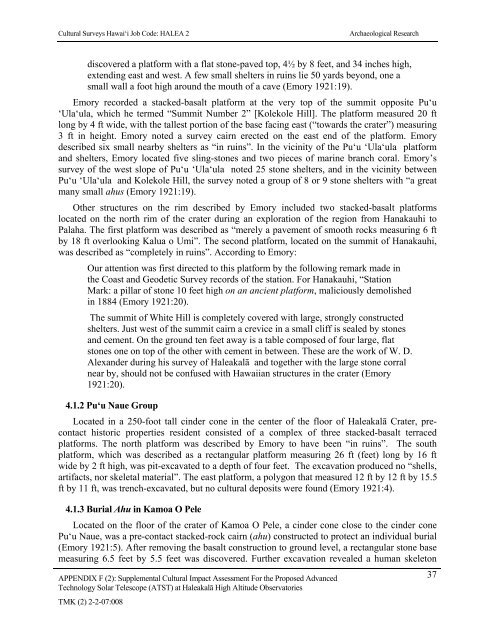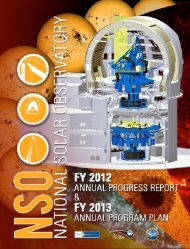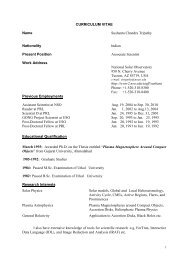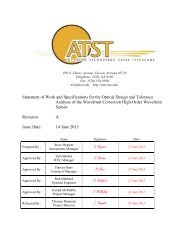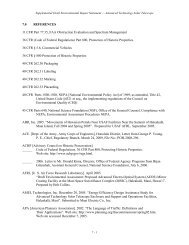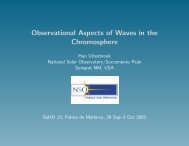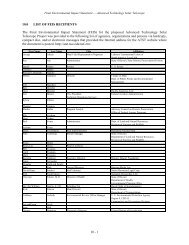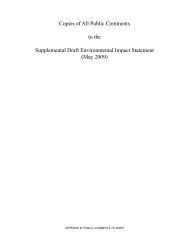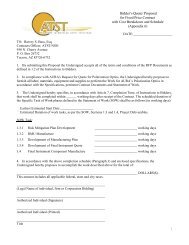F2 - ATST
F2 - ATST
F2 - ATST
Create successful ePaper yourself
Turn your PDF publications into a flip-book with our unique Google optimized e-Paper software.
Cultural Surveys Hawai‘i Job Code: HALEA 2Archaeological Researchdiscovered a platform with a flat stone-paved top, 4½ by 8 feet, and 34 inches high,extending east and west. A few small shelters in ruins lie 50 yards beyond, one asmall wall a foot high around the mouth of a cave (Emory 1921:19).Emory recorded a stacked-basalt platform at the very top of the summit opposite Pu‘u‘Ula‘ula, which he termed “Summit Number 2” [Kolekole Hill]. The platform measured 20 ftlong by 4 ft wide, with the tallest portion of the base facing east (“towards the crater”) measuring3 ft in height. Emory noted a survey cairn erected on the east end of the platform. Emorydescribed six small nearby shelters as “in ruins”. In the vicinity of the Pu‘u ‘Ula‘ula platformand shelters, Emory located five sling-stones and two pieces of marine branch coral. Emory’ssurvey of the west slope of Pu‘u ‘Ula‘ula noted 25 stone shelters, and in the vicinity betweenPu‘u ‘Ula‘ula and Kolekole Hill, the survey noted a group of 8 or 9 stone shelters with “a greatmany small ahus (Emory 1921:19).Other structures on the rim described by Emory included two stacked-basalt platformslocated on the north rim of the crater during an exploration of the region from Hanakauhi toPalaha. The first platform was described as “merely a pavement of smooth rocks measuring 6 ftby 18 ft overlooking Kalua o Umi”. The second platform, located on the summit of Hanakauhi,was described as “completely in ruins”. According to Emory:Our attention was first directed to this platform by the following remark made inthe Coast and Geodetic Survey records of the station. For Hanakauhi, “StationMark: a pillar of stone 10 feet high on an ancient platform, maliciously demolishedin 1884 (Emory 1921:20).The summit of White Hill is completely covered with large, strongly constructedshelters. Just west of the summit cairn a crevice in a small cliff is sealed by stonesand cement. On the ground ten feet away is a table composed of four large, flatstones one on top of the other with cement in between. These are the work of W. D.Alexander during his survey of Haleakalā and together with the large stone corralnear by, should not be confused with Hawaiian structures in the crater (Emory1921:20).4.1.2 Pu‘u Naue GroupLocated in a 250-foot tall cinder cone in the center of the floor of Haleakalā Crater, precontacthistoric properties resident consisted of a complex of three stacked-basalt terracedplatforms. The north platform was described by Emory to have been “in ruins”. The southplatform, which was described as a rectangular platform measuring 26 ft (feet) long by 16 ftwide by 2 ft high, was pit-excavated to a depth of four feet. The excavation produced no “shells,artifacts, nor skeletal material”. The east platform, a polygon that measured 12 ft by 12 ft by 15.5ft by 11 ft, was trench-excavated, but no cultural deposits were found (Emory 1921:4).4.1.3 Burial Ahu in Kamoa O PeleLocated on the floor of the crater of Kamoa O Pele, a cinder cone close to the cinder conePu‘u Naue, was a pre-contact stacked-rock cairn (ahu) constructed to protect an individual burial(Emory 1921:5). After removing the basalt construction to ground level, a rectangular stone basemeasuring 6.5 feet by 5.5 feet was discovered. Further excavation revealed a human skeletonAPPENDIX F (2): Supplemental Cultural Impact Assessment For the Proposed Advanced 37Technology Solar Telescope (<strong>ATST</strong>) at Haleakalā High Altitude ObservatoriesTMK (2) 2-2-07:008


